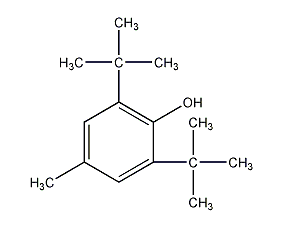
Structural formula
| Business number | 03LG |
|---|---|
| Molecular formula | C15H24O |
| Molecular weight | 220.36 |
| label |
2,6-di-tert-butyl-4-methylphenol, Antioxidant and anti-adhesive agent T501, 2,6-di-tert-butyl-p-cresol, BHT, Anti-aging agent 264; dibutyl hydroxytoluene, 2,6-di-tert-butyl-4-methylphenol, Antioxidant defense glue T501; Dibutyl hydroxy toluene, BHT, Antioxidants, rubber antioxidant, stabilizer, Feed additives |
Numbering system
CAS number:128-37-0
MDL number:MFCD00011644
EINECS number:204-881-4
RTECS number:GO7875000
BRN number:1911640
PubChem number:24891585
Physical property data
1. Properties: colorless crystal or white crystalline powder, odorless and tasteless. The color turns yellow when exposed to light and gradually becomes darker.
2. Relative density (20/4℃): 0.8937
3. Refractive index (n75 D): 1.4859
4. Melting point (℃): 71
5. Boiling point (ºC): 265
6. Flash point ( ℃): 127
7. Viscosity (80℃, mPa): 3.74
8. Solubility: easily soluble in ethanol (25%, 25℃), acetone (40% ), benzene (40%), soybean oil, cottonseed oil, lard, insoluble in water, glycerol, and propylene glycol.
9. Refractive index at room temperature (n25): 1.489575
10. Relative density (25℃, 4℃ ): 0.89980
Toxicological data
1. Acute toxicity: LD50: 1700-1970mg/Kg (orally in rats); LC501040mg/kg in mice
2. Contact with skin can cause dermatitis, allergy, and splashing Rinse immediately with water after contact with skin and clothing. Operators should wear protective equipment.
Ecological data
There is some harm to water bodies.
Molecular structure data
1. Molar refractive index: 69.73
2. Molar volume (cm3/mol): 237.5
3. Isotonic specific volume (90.2K ): 556.0
4. Surface tension (dyne/cm): 30.0
5. Polarizability (10-24cm3): 27.64
Compute chemical data
1. Reference value for hydrophobic parameter calculation (XlogP): 5.3
2. Number of hydrogen bond donors: 1
3. Number of hydrogen bond acceptors: 1
4. Number of rotatable chemical bonds: 2
5. Number of tautomers: 2
6. Topological molecule polar surface area 20.2
7. Number of heavy atoms: 16
8. Table� is a gelling inhibitor. The general dosage in rubber is 0.5-3 parts. When the dosage is increased to 3-5 parts, it will not bloom. This product can also be used as a stabilizer during post-processing and storage of synthetic rubber, and can be used for styrene-butadiene rubber, butadiene rubber, ethylene-propylene rubber, chloroprene rubber and other types of rubber. Antioxidant 264 is an effective antioxidant in some polymer materials. This product is an effective stabilizer in polyethylene, polyvinyl chloride (dosage 0.01-0.1%) and polyvinyl ether. Antioxidant 264 is an excellent antioxidant additive for various petroleum products. Good oil solubility. This product can also be used as an antioxidant in the food processing industry and used in foods containing a lot of fat. The dosage in oils and fats, butter, dried fish and shellfish products, salted fish and shellfish products, frozen whale meat products, etc. is below 0.2g/kg, and in chewing gum is below 0.75g/kg. The usage of this product includes dipping method, direct mixing method, mixing method after dissolving in ethanol, and spraying method. The United States, Japan and the European Community all regard this product as a legal feed additive. The European Community stipulates that the maximum dosage in feed is 150ppm and can be used in various feeds.
2. BHT is an oil-soluble antioxidant widely used at home and abroad. Although it is highly toxic, it has strong antioxidant capacity, good heat resistance and stability, has no specific odor, and has no shortcomings such as color reaction when encountering metal ions. It is also cheap, only 1/5 to 1/1 of BHA. 8. It is still used as the main antioxidant in my country. It is generally used in conjunction with BHA and uses citric acid or other organic acids as synergists. Our country stipulates that it can be used in edible oils and fats, fried foods, biscuits, instant noodles, quick-cooked rice, canned nuts, dried fish products and cured meat products, with a maximum usage of 0.2g/kg. This product also has a certain antibacterial effect, but it is weaker than BHA.
3. One of the universal phenolic antioxidants. Used as a non-polluting antioxidant, it can effectively inhibit air oxidation, thermal degradation and copper damage. It can be used as antioxidant and heat stabilizer for polyolefin, polyester, polystyrene, ABS resin, polyvinyl chloride, cellulose resin, etc. In the rubber industry, it is used as an antioxidant and anti-deterioration agent for natural rubber and synthetic rubbers such as styrene-butadiene, butyl, chloroprene, nitrile-butadiene, ethylene-propylene, and cis-butadiene. It is also used as an antioxidant in petroleum products, EVA hot melt adhesives, unsaturated fatty acid coatings, etc. Food-grade di-tert-butyl-p-cresol is a permitted food antioxidant and can be used in oils, baked goods, fried foods, cereal foods, dairy products, meat products and preserves. It can also be used as an antioxidant in cosmetics, spices, feed, etc. In addition, it can also be used as an additive for lubricants and fuel oils to improve oil stability. The dosage is usually 0.05% ~ 1.0%.

 微信扫一扫打赏
微信扫一扫打赏

